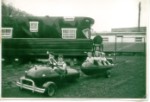Hi all Foamlings...
I thought there was already a thread on this, and looked, but
didn't see one so, "Here One Is" now:
This will probably be my approach when I get around to
doing one. 'Thought it'd be good to corral info on them in
one place, so here goes the first post:
Here is an interesting design for an expanding Pontoon Craft
that uses self-built plywood-foam-plywood SIPs:
http://www.elasticat.com/
And this page gives his method of plywood-foam-plywood
composite construction, using fiberlass and epoxy as exterior covering:
http://www.elasticat.com/compositepanels.html
- - - - - - - - - -
The following info is from some earlier posts I did on various different threads,
just cut and pasted to here for the info/links:
I think SIPs are a good idea and I will probably use a form of them
whenever I get to build. [Too many house projects are a priority
at the moment.] For a larger size construction, I'd seriously look
into them. I consider them a Foamie variation.
Anyway, check out linuxmanxxx's post/builds.
Here's the link to them:
search.php?st=0&sk=t&sd=d&sr=posts&author_id=11546
He is using a small scale version of them and gives details on how he did them -
they'll be a reference for me in the future. He uses them in his business:
http://www.microcampers.com/ Just browse through them until you reach one
that pertains to his SIPs and then click on the thrtead title if you need context.
Here are some links to a SIP builder with a difference. [compared to those
SIPs that are used for house construction.] They are in Washington State,
and make many different kinds/thicknesses of them. Quite an interesting product.
http://www.superhoneycomb.com/
http://singcore.com/
http://singcore.com/tiny_index.html
http://media.designerpages.com/3rings/2 ... ing-homes/
Here are a couple links for them being used:
A gal in Washington State is building a tenwide Tiny House, using them:
http://mytinyabode.blogspot.com/
And her Dad is using them to remodel a vintage Airfloat TT:
http://www.everyonecandance.com/Airfloat_Process.html
- - - - - - - -
I've also been wondering about a variation on the Mini-SIP that'd use
the stitch-n-glue boat building method. http://www.boatbuilder.org/
With that I'd basically build the inside walls of 1/4in plywood with the S-n-G
method, frame any/the openings perimeters and the outside edges
with the appropriate size 1x wood or such, and then glue in the foam
[most likely in the appropriate shaped/sized pieces vs a large sheet]
to cover the outside of the interior 1/4in plywood walls and thus help
insulate [an uninsulated trailer is a poor accomodation in my personal
view] and fill out the form of the body of the trailer. Any seams and gaps
would be minimized while applying the foam pieces, but any remaining
can be filled in with one of the canned gap filling foams, and then all
that'd be faired out with some kind of fillers to try and make a smooth
surface for the outside skin. After that, I'd probably go with either a
fabric and glue and paint or fiberglass cloth and epoxy as the outside
skin. It all depends on costs and if I could even tolerate the fiberglassing
fumes. [Epoxy is supposedly less "fumey" than the polyester type, but I
do have allergy problems with some chemicals, so it'll remain to be seen
if that could even be a possibility.] Some kind of foamcoat is another
alternative too, but they are more expensive than the old-time fabric-
glue-paint method.
Cheers,
Norm/memzo
Mini SIPs As A Foamy Technique
Moderator: eaglesdare
9 posts
• Page 1 of 1
Mini SIPs As A Foamy Technique
Last edited by mezmo on Sun Mar 03, 2013 1:07 am, edited 1 time in total.
If you have a house - you have a hobby.
-

mezmo - 1000 Club

- Posts: 1817
- Images: 194
- Joined: Fri Jan 01, 2010 4:11 am
- Location: Columbia, SC
Re: Mini SIPs As A Foamy Technique
Sips are sure a good idea , the only problem is the quality of materials used ... I’m trying to get away from using plywood altogether ... Thinking more along the lines of a Thick chipboard replacing the plywood ... Lighter , cheaper , easier to waterproof/paint , and doesn’t de-laminate by itself in our notorious Humidity ... Easier to repair too, damages being more localized... as with those mini frozen Turkeys ...  Just an alternative SIP really ...
Just an alternative SIP really ... 
Thing too with wood/foam/wood SIPS , you don’t save any weight really ... Two sheets of 1/4” ply , plus the weight of the foam and glue and you’re in the weight neighborhood of a 3/4” sheet of standard plywood ...
 Just an alternative SIP really ...
Just an alternative SIP really ... 
Thing too with wood/foam/wood SIPS , you don’t save any weight really ... Two sheets of 1/4” ply , plus the weight of the foam and glue and you’re in the weight neighborhood of a 3/4” sheet of standard plywood ...

There’s no place like Foam !
-

GPW - Gold Donating Member
- Posts: 14920
- Images: 546
- Joined: Thu Feb 09, 2006 7:58 pm
- Location: New Orleans


 Look for pic's soon on my TPCE build thread!
Look for pic's soon on my TPCE build thread!